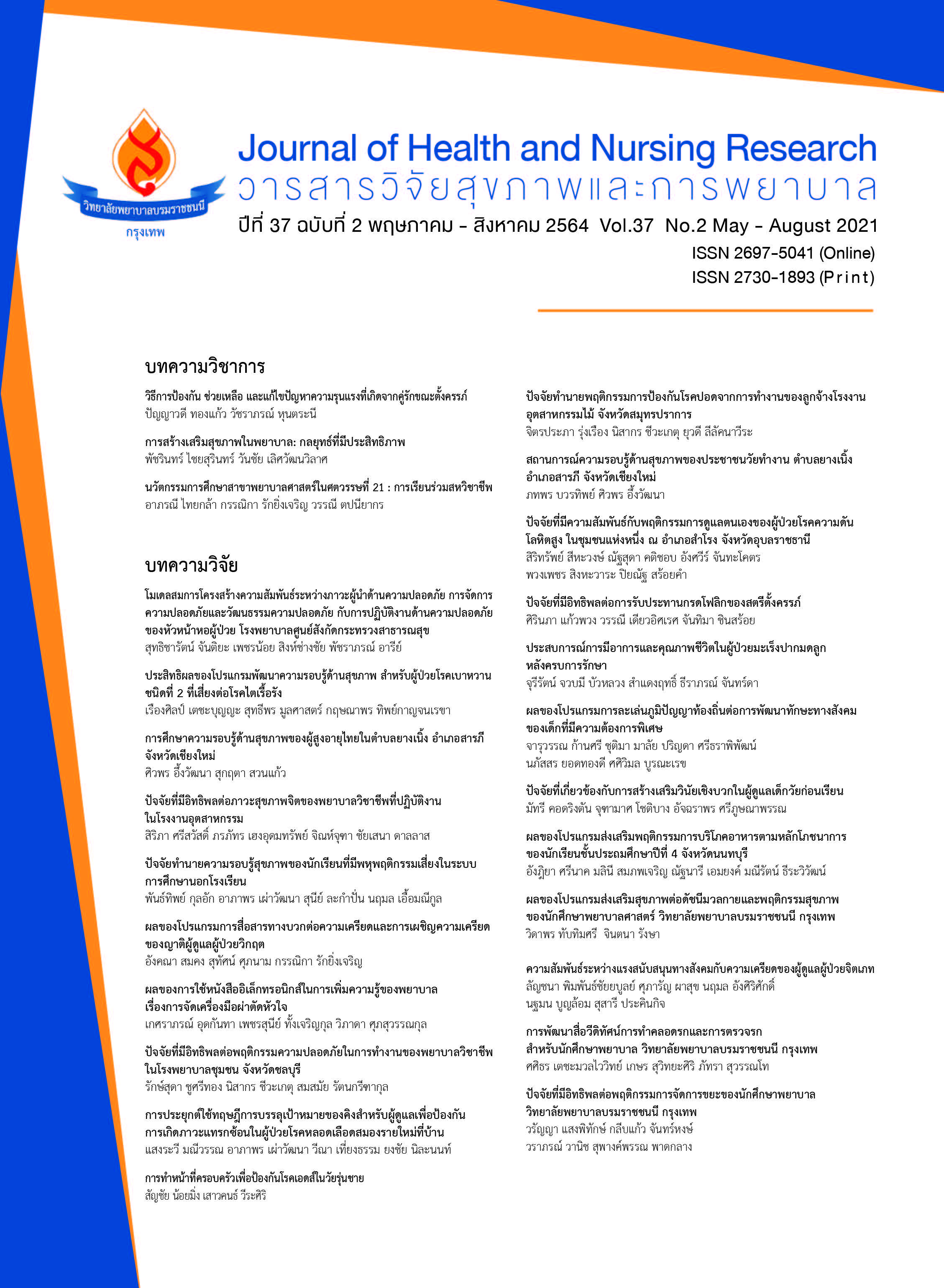ปัจจัยที่มีอิทธิพลต่อการรับประทานกรดโฟลิกของสตรีตั้งครรภ์
คำสำคัญ:
กรดโฟลิก, สตรีตั้งครรภ์, การเตรียมความพร้อมก่อนตั้งครรภ์บทคัดย่อ
บทนำ: การรับประทานกรดโฟลิกก่อนตั้งครรภ์และขณะตั้งครรภ์สามารถป้องกันความพิการของทารกในครรภ์ได้ แต่ในปัจจุบันสตรีตั้งครรภ์มีการปฏิบัติอย่างจำกัด วัตถุประสงค์การวิจัย: เพื่อศึกษาปัจจัยที่มีอิทธิพลต่อการรับประทานกรดโฟลิกของสตรีตั้งครรภ์ ระเบียบวิธีวิจัย: การวิจัยครั้งนี้เป็นการวิจัยแบบบรรยายเชิงทำนาย กลุ่มตัวอย่างคือ สตรีตั้งครรภ์แรกที่มารับบริการ ณ หน่วยฝากครรภ์โรงพยาบาลสมเด็จพระบรมราชเทวี ณ ศรีราชาจำนวน 130 ราย ใช้วิธีการคัดเลือกกลุ่มตัวอย่างแบบตามสะดวก เครื่องมือการวิจัยประกอบด้วย แบบสอบถามข้อมูลทั่วไป แบบวัดความรู้เกี่ยวกับกรดโฟลิก มีค่าความเชื่อมั่น .79 แบบสอบถามการได้รับข้อมูลเกี่ยวกับกรดโฟลิก มีค่าความเชื่อมั่น .80 แบบสอบถามการรับรู้อุปสรรคในการรับประทานกรดโฟลิก มีค่าความเชื่อมั่น .78 แบบสอบถามทัศนคติเกี่ยวกับการรับประทานกรดโฟลิก มีค่าความเชื่อมั่น .82 แบบสอบการรับประทานกรดโฟลิกก่อนและขณะตั้งครรภ์ มีค่าความเชื่อมั่น .89 เก็บรวบรวมข้อมูลโดยใช้แบบสอบถามในช่วงเดือนมิถุนายน-เดือนสิงหาคม 2562 วิเคราะห์ข้อมูลด้วยสถิติความถี่ ร้อยละ ค่าเฉลี่ย ส่วนเบี่ยงเบนมาตรฐานและสถิติถดถอยโลจิสติก ผลการวิจัย: พบว่า สตรีตั้งครรภ์ที่รับประทานกรดโฟลิก 3 เดือนก่อนตั้งครรภ์จนถึง 3 เดือนแรกของการตั้งครรภ์ร้อยละ 7.70 ปัจจัยที่มีอิทธิพลต่อการรับประทานกรดโฟลิกของสตรีตั้งครรภ์อย่างมีนัยสำคัญทางสถิติ ได้แก่ ความรู้เกี่ยวกับกรดโฟลิก (AOR = 17.46, 95% CI = 1.40-217.63) การได้รับข้อมูลเกี่ยวกับกรด โฟลิก (AOR = 208.07, 95% CI = 3.97-10903.52) และการรับรู้อุปสรรคในการรับประทานกรดโฟลิก (AOR = .79, 95% CI = .62-1.00) และปัจจัยที่ไม่มีอิทธิพลต่อการรับประทานกรดโฟลิกของสตรีตั้งครรภ์ ได้แก่ ทัศนคติเกี่ยวกับการรับประทานกรดโฟลิก (AOR = .72, 95% CI = .46-1.14) สรุปผล: สตรีตั้งครรภ์มีพฤติกรรมการรับประทานกรดโฟลิกก่อนตั้งครรภ์และขณะตั้งครรภ์น้อย ซึ่งเป็นประเด็นปัญหาที่สำคัญ ดังนั้นบุคลากรทางสุขภาพควรตระหนักเพื่อป้องกันความพิการของทารกในครรภ์ ข้อเสนอแนะ: จากการวิจัยครั้งนี้มีข้อเสนอแนะว่า บุคลากรทางสุขภาพควรนำผลการวิจัยไปใช้เป็นแนวทางในการรณรงค์ให้สตรีมีความรู้เกี่ยวกับกรดโฟลิกที่ถูกต้อง และจัดกิจกรรมส่งเสริมให้สตรีวัยเจริญพันธุ์รับประทานกรดโฟลิกเพื่อเตรียมตนเองให้พร้อมก่อนการตั้งครรภ์
Downloads
เอกสารอ้างอิง
[cited 2018 Nov 15]. Available from: http://bps.moph.go.th/new_bps/sites/
default/files/health_statistic2558.pdf. (in Thai)
2. Ministry of Public Health. The 2nd National Reproductive Health Development Policy and Strategy (2017-2026) on the Promotion of Quality Birth and Growth [Internet]. 2018[cited 2018 Nov 15]. Available from: http://rh.anamai.moph.go.th/ewt_dl_link.php?nid=240
3. Department of Maternal and Child Health, Regional Health Promotion Center 7 Ubon Ratchathani, Department of Health. Training Guide Prenatal Preparation Course for Quality Parents (Preconception care) for spouses. Ubon Ratchathani:We can service express; 2010. (in Thai)
4. World Health Organization [WHO]. Preconception care: Maximizing the gains for maternal and child health [Internet]. 2013[cited 2019 Jan 15]. Available from: http://www.who.int/ maternal_child_adolescent/documents/preconception_care_policy_brief.pdf.
5. Centers for Disease Control and Prevention [CDC]. Recommendations to improve preconception health and health care: United states [Internet]. 2006[cited 2019 Jan 15]. Available from: http://www.cdc.gov/mmwr/preview/mmwrhtml/rr5506a1.htm
6. Mazz D, Chapman A. Improving the uptake of preconception care and periconceptional folate supplementation: What do women think. Biological Medicine Central Public Health 2010; 10:1-6.
7. Johnson CY, Little J. Folate intake, makers of folate status and oral clefts: is the evidence converging?. International journal epideminol 2008;37(5):1041-58.
8. Li N, Li Z, Ye R, Liu J, Ren A. Impact of periconceptional folic acid supplementation on low birth weight and small-for-gestational-age Infants in China: A large prospective cohort study. The journal of pediatrics 2017;187:105-10.
9. Bureau of Nutrition (BoN), Department of Health, Ministry of Public Health.Public health promotes Thai girl cheeks policy Have children for life with wonderful vitamins [Internet]. 2017 [cited 2018 Nov 15]. Available from: http://nutrition.anamai.moph.go.th/ewt_news. php?nid=433&filename=index. (in Thai)
10. Xing XY, Tao FB, Hao JH, Huang K, Huang ZH, Zhu XM, et al. Periconceptional folic acid supplementation among women attending antenatal clinic in Anhui, China: Data from a population-based cohort study. Midwifery 2012;28(3):291-7.
11. Kim MJ, Kim J, Hwang EJ, Song YJ, Kim H, Hyun T. (2018). Awareness, knowledge, and use of folic acid among non-pregnant Korean women of childbearing age. Nutrition Research and Practice 2018;12(1):78-84.
12. Bixenstine PJ, Cheng TL, Cheng D, Connor KA, Mistry KB. Association between preconception counseling and folic acid supplementation before pregnancy and reasons for non-use. Maternal Child Health Journal 2019;19(9):1974-84.
13. Wongkham J, Ratanasiri T, Paibool M, Chatvised P, Suttasee N, Saksiriwuttho P, et al. Maternal Knowledge and Attitude on Folic Acid Intakes to Prevent Birth Defects of Pregnant Women. Srinagarind Medical Journal 2016;31(4):192-6. (in Thai)
14. Kaewpoung S, Deoisres W, Suppaseemanont W. Influencing of Perception of Pregnancy Risk, Knowledge, and Attitude on Preconception Health Behavior among Pregnant Women.The Journal of Faculty of Nursing Burapha University 2018;26(2):57-66.
15. Janz NK, Becker MH. The health belief model: A decade later. Health Education Quarterly 1984;11(1): 1-47.
16. Rofail D, Colligs A, Abetz1 L, Lindemann M, Maguire1 L. Factors contributing to the success of folic acid public health campaigns. Journal of Public Health 2011;34(1):90-9.
17. Bitzer J, Stenglin A, Bennemerschult R. Women's awareness and periconceptional use of folic acid: Data from a large Europeansurvey. International Journal of Women’s Health 2013;5:201-13.
18. Liang H, Ma D, Zhou S, Li X. Knowledge and use of folic acid for birth defect prevention among women of childbearing age in Shanghai, China: A prospective cross-sectional study. Medical Science Monitor 2011;17(12):87-92.
19. Auriel E, Biderman A, Belmaker I, Freud T, Peleg R. Knowledge, attitudes, and practice among women and doctors concerning the use of folic acid. ISRN obstetrics and gynecology 2010;2011:1-5.
20. Agricola E, Pandolfi MV, Gonfiantini F, Gesualdo M, Romano E, Carloni, E, et al. (). A cohort study of a tailored web intervention for preconception care. Biological Medicine Central Journal 2014; 33: 1-10.
ดาวน์โหลด
เผยแพร่แล้ว
รูปแบบการอ้างอิง
ฉบับ
ประเภทบทความ
สัญญาอนุญาต
บทความที่ได้รับการตีพิมพ์ เป็นลิขสิทธิ์ของวารสารวิจัยสุขภาพและการพยาบาล (วิทยาลัยพยาบาลบรมราชชนนี กรุงเทพ) ไม่สามารถนำไปตีพิมพ์ซ้ำในวารสารฉบับอื่น


















